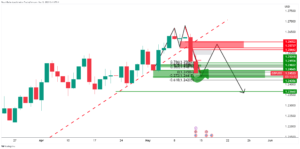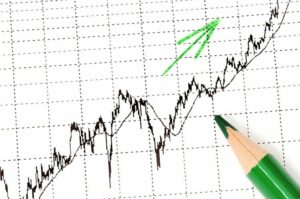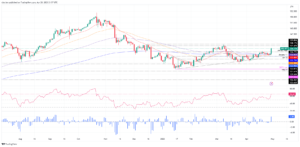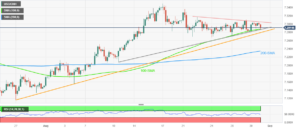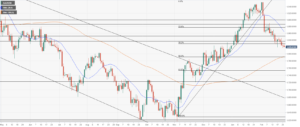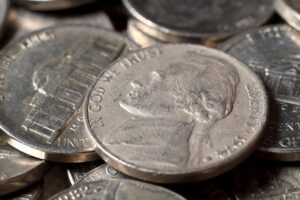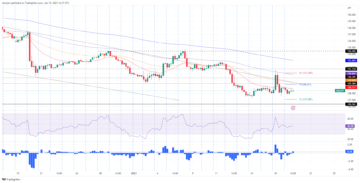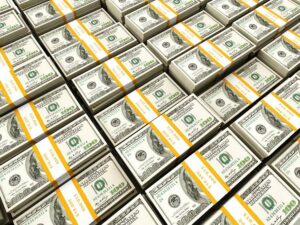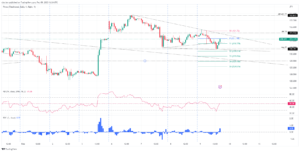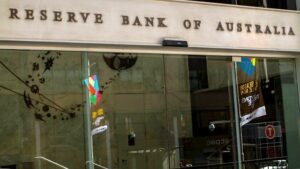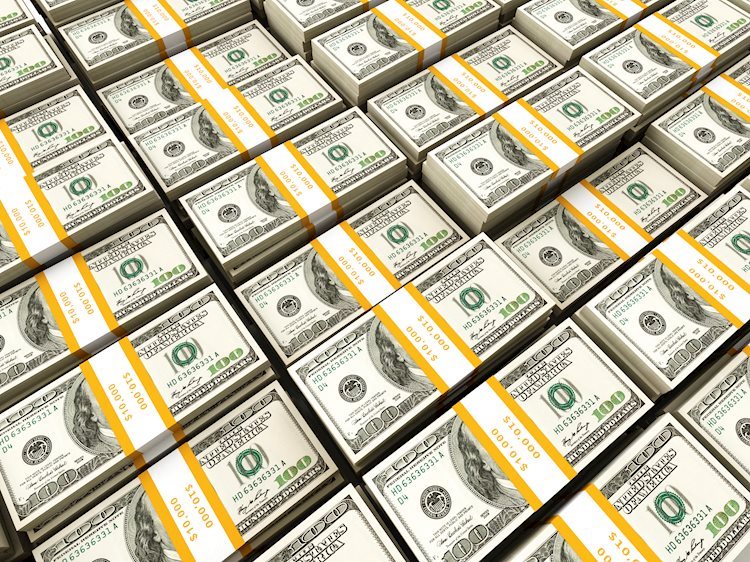
- US Dollar stages a rebound following Monday’s selloff.
- Top-tier economic data and tech earnings from the United States this week to affect USD valuation.
- The daily technical setup for the US Dollar Index continues to favor bears in the near term.
The United States Dollar (USD) is correcting from weekly lows, as bulls find their footing amid broad risk-aversion. Rising tensions over the approaching US debt ceiling deadline and a lack of clarity on the Federal Reserve (Fed) interest rates outlook weigh on the market sentiment. Investors readjust their US Dollar positions, bracing for a week of high-profile quarterly earnings and closely watched economic data from the United States.
Meanwhile, The European Central Bank (ECB), the Bank of Japan (BoJ), the Bank of England (BoE) and the Swiss National Bank (SNB) announced in a joint statement that they will reduce the frequency of their dollar operations with the Fed from May 1 as the volatility in financial markets has receded. This announcement seems to be providing an additional support to the USD.
Earnings this week include a spate of potential market movers, including tech and tech-adjacent Alphabet Inc, Microsoft Corp, Meta Platforms Inc and Amazon.com. On the macroeconomic front, the first quarter Gross Domestic Product (GDP) and April Personal Consumption Expenditures (PCE) Price Index will be closely scrutinized in the second half of this week. In the meantime, the mid-tier US Conference Board Consumer Confidence data and housing data will entertain US Dollar traders.
The US Dollar Index, which tracks the USD performance against a basket of six major currencies, rises toward 102.00 on Tuesday after having lost nearly 0.5% on Monday.
Daily digest market movers: US Dollar continues to gather strength
- House prices in the US rose by 0.5% on a monthly basis in February, the monthly data published by the US Federal Housing Finance Agency showed on Tuesday. This reading followed January’s increase of 0.1% (revised from +0.2%) and came in better than the market expectation for a decrease of 0.2%.
- Consumer sentiment in the US weakened modestly in April with the Conference Board’s Consumer Confidence Index edging lower to 101.3 from 104.0 in March (revised from 104.2).
- Sales of new single‐family houses rose by 9.6% in March to a seasonally adjusted annual rate of 683,000, the data published jointly by the US Census Bureau and the Department of Housing and Urban Development showed on Tuesday.
- On Monday, the Federal Reserve Bank of Chicago announced that the National Activity Index remained unchanged at -0.19 in March. Meanwhile, the Federal Reserve Bank of Dallas’ Texas Manufacturing Survey showed that the headline Business Index plunged to -223.4 in April from -15.7 in March.
- Wall Street’s main indices opened in negative territory following Monday’s mixed closing.
- Troubled US bank, First Republic Bank, shares sank over 20% after market hours, as it said deposits plunged by more than $100 billion in the first quarter.
- Concerns persist over the approaching US debt ceiling deadline. The House of Representatives is expected to vote on a Republican-led debt and spending bill this week.
- 10-year US Treasury bond yields keep falling toward the 3.40% after breaching the 3.50% key level on Monday.
- Markets are currently pricing a roughly 90% probability of a 25 basis points Federal Reserve (Fed) rate hike at the upcoming meeting, according to the CME Group FedWatch Tool.
- The Fed is in the blackout period ahead of its May 3 monetary policy announcements.
- This Tuesday, the Conference Board’s Consumer Confidence data for April from the United States will be reported alongside the New Home Sales data.
- Earnings from US tech giants Microsoft Corp, which backs ChatGPT, and Google parent Alphabet Inc, top the watchlist on Tuesday.
- The US Bureau of Economic Analysis will unveil the first estimate of first-quarter GDP growth on Thursday. The US economy is forecast to expand at an annualized rate of 2% in Q1, down from the 2.6% recorded in the last quarter of 2022.
Technical analysis: US Dollar Index tries to gather bullish momentum
The US Dollar Index (DXY) is pushing higher toward 102.00 as the rebound from weekly troughs continues. The recovery could gain traction if DXY manages to yield a daily closing above the bearish 21-Day Moving Average (DMA). It is worth noting that the index has failed to settle above the 21 DMA since March 15 on a daily candlestick closing basis.
Acceptance above the latter could initiate a fresh upswing toward the 102.50 psychological barrier, beyond which the confluence of the downward-sloping 50 and 100 DMAs at around 103.30 will be on buyers’ radars.
With the 14-day Relative Strength Index (RSI), however, still below the 50.00 level, the recovery attempts in DXY are likely to be sold into. Immediate support is seen at the intraday low of 101.19, below which the 101.00 round number will challenge the bullish commitments. Deeper declines will seek validation from the multi-month low reached on April 14 at 100.78.
How does Fed’s policy impact US Dollar?
The US Federal Reserve (Fed) has two mandates: maximum employment and price stability. The Fed uses interest rates as the primary tool to reach its goals but has to find the right balance. If the Fed is concerned about inflation, it tightens its policy by raising the interest rate to increase the cost of borrowing and encourage saving. In that scenario, the US Dollar (USD) is likely to gain value due to decreasing money supply. On the other hand, the Fed could decide to loosen its policy via rate cuts if it’s concerned about a rising unemployment rate due to a slowdown in economic activity. Lower interest rates are likely to lead to a growth in investment and allow companies to hire more people. In that case, the USD is expected to lose value.
The Fed also uses quantitative tightening (QT) or quantitative easing (QE) to adjust the size of its balance sheet and steer the economy in the desired direction. QE refers to the Fed buying assets, such as government bonds, in the open market to spur growth and QT is exactly the opposite. QE is widely seen as a USD-negative central bank policy action and vice versa.
- SEO Powered Content & PR Distribution. Get Amplified Today.
- Platoblockchain. Web3 Metaverse Intelligence. Knowledge Amplified. Access Here.
- Minting the Future w Adryenn Ashley. Access Here.
- Source: https://www.fxstreet.com/news/us-dollar-corrects-as-focus-shifts-to-us-tech-earnings-economic-data-202304251000
- :has
- :is
- 000
- 1
- 100
- 102
- 2%
- 2022
- 50
- 7
- 9
- a
- About
- above
- According
- Action
- activity
- Additional
- Adjusted
- affect
- After
- against
- agency
- ahead
- alongside
- Alphabet
- also
- Amazon
- Amazon.com
- Amid
- an
- analysis
- and
- announced
- Announcement
- Announcements
- annual
- annualized
- approaching
- April
- April 14
- ARE
- around
- AS
- Assets
- At
- Attempts
- average
- Balance
- Balance Sheet
- Bank
- Bank of England
- Bank of England (BOE)
- bank of japan
- Bank of Japan (BoJ)
- Banks
- barrier
- basis
- basket
- BE
- bearish
- Bears
- below
- Better
- Beyond
- Bill
- Billion
- board
- BoE
- boj
- bond
- Bond yields
- Bonds
- Borrowing
- broad
- Bullish
- Bulls
- Bureau
- business
- but
- Buying
- by
- case
- ceiling
- Census
- Census Bureau
- central
- Central Bank
- Central Banks
- challenge
- ChatGPT
- chicago
- clarity
- closely
- closing
- CME
- CME Group
- COM
- Companies
- concerned
- Conference
- conference board
- confidence
- Confidence Index
- consumer
- consumption
- continues
- Corp
- Cost
- could
- currencies
- Currently
- cuts
- daily
- Dallas
- data
- Debt
- decide
- Declines
- decrease
- deeper
- Department
- deposits
- desired
- Development
- Digest
- direction
- dma
- Dollar
- dollar index
- Domestic
- down
- Dxy
- Earnings
- easing
- ECB
- Economic
- Economic Analysis
- economy
- employment
- encourage
- England
- entertain
- estimate
- European
- European Central Bank
- exactly
- Expand
- expectation
- expected
- Failed
- Falling
- favor
- February
- Fed
- Federal
- federal reserve
- Federal Reserve Bank
- finance
- financial
- Find
- First
- followed
- following
- For
- Forecast
- Frequency
- fresh
- from
- front
- Gain
- Gains
- GDP
- gdp growth
- Goals
- Government
- government bonds
- Group
- Growth
- Half
- hand
- having
- headline
- high-profile
- higher
- Hike
- hire
- Home
- HOURS
- House
- house of representatives
- houses
- housing
- However
- HTTPS
- immediate
- Impact
- in
- include
- Including
- Increase
- index
- Indices
- inflation
- initiate
- interest
- INTEREST RATE
- Interest Rates
- into
- investment
- Investors
- IT
- ITS
- January
- Japan
- joint
- jpg
- Keep
- Key
- Lack
- Last
- lead
- Level
- likely
- lose
- Low
- Lows
- Macroeconomic
- Main
- major
- manages
- mandates
- manufacturing
- March
- Market
- Markets
- maximum
- May..
- meantime
- Meanwhile
- meeting
- Meta
- META PLATFORMS
- Microsoft
- mixed
- Monday
- Monetary
- Monetary Policy
- money
- money supply
- monthly
- monthly data
- more
- Movers
- moving
- moving average
- National
- National Bank
- Near
- nearly
- negative
- negative territory
- New
- number
- of
- on
- open
- opened
- Operations
- opposite
- or
- Other
- Outlook
- over
- pce
- People
- performance
- period
- personal
- Platforms
- plato
- Plato Data Intelligence
- PlatoData
- points
- policy
- positions
- potential
- price
- Prices
- pricing
- primary
- probability
- providing
- psychological barrier
- published
- Pushing
- Q1
- QE
- QT
- quantitative
- Quantitative Easing
- quantitative tightening
- Quarter
- raising
- Rate
- Rate Hike
- Rates
- reach
- reached
- Reading
- rebound
- recorded
- recovery
- reduce
- refers
- relative strength index
- Relative Strength Index (RSI)
- remained
- Reported
- Representatives
- Republic
- Reserve
- reserve bank
- Rises
- rising
- ROSE
- roughly
- round
- rsi
- s
- Said
- sales
- saving
- scenario
- Second
- Seek
- seems
- seen
- SellOff
- sentiment
- settle
- setup
- Shares
- since
- SIX
- Size
- Slowdown
- SNB
- sold
- Spending
- Stability
- stages
- Statement
- States
- Still
- street
- strength
- such
- supply
- support
- Survey
- Swaps
- Swiss
- Swiss National Bank (SNB)
- tech
- tech giants
- Technical
- territory
- texas
- than
- that
- The
- the Fed
- their
- they
- this
- this week
- tightening
- to
- tool
- top
- toward
- traction
- Traders
- treasury
- Tuesday
- unemployment
- unemployment rate
- United
- United States
- upcoming
- urban
- us
- US Bank
- US Census
- US Conference Board Consumer Confidence
- US Debt
- US Dollar
- US Dollar Index
- US economy
- US Federal
- us federal reserve
- US Treasury
- USD
- validation
- Valuation
- value
- via
- Volatility
- Vote
- week
- weekly
- weigh
- which
- widely
- will
- with
- worth
- Yield
- yields
- zephyrnet

